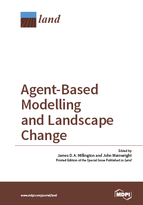Agent-Based Modelling and Landscape Change
A special issue of Land (ISSN 2073-445X).
Deadline for manuscript submissions: closed (30 April 2015) | Viewed by 82056
Special Issue Editors
Interests: agent-based modelling; landscape ecology; land use/cover change modelling; coupled human and natural systems
Special Issue Information
Dear Colleagues,
The use of agent-based models (ABMs) and modelling for understanding landscape change and dynamics continues to grow. One reason for the popularity of ABMs is that they provide a framework to represent multiple, discrete, multi-faceted, heterogeneous actors (human or otherwise) and their relationships and interactions between one another and their environment, through time and across space. This special issue seeks to showcase innovative uses of ABMs for investigating and explaining landscape change and dynamics and to explore and identify how researchers in different disciplines can learn from one another to further innovate. Thus, this special issue will emphasise multidisciplinary dialogue between researchers using ABM in physical geography, hydrology, ecology, land change science, economics, alternative histories, archaeology, sociology, psychology and others. Innovation may come in the form of computational, conceptual, analytical, participatory or epistemological advances in the use of ABM for a range of aims and motivations associated with landscape change and dynamics. Modelling advances may include new ways of representing agent decisions and/or interactions, establishing and evaluating model structures and rules, presenting and visualising change, multi-scale analysis, comparative techniques, narrative methods, and more. The presentation of innovative agent-based modelling from diverse research backgrounds and perspectives will demonstrate opportunities for learning and enable dialogue to enhance future use of ABMs for understanding landscape change.
Dr. James Millington
Prof. John Wainwright
Guest Editors
Manuscript Submission Information
Manuscripts should be submitted online at www.mdpi.com by registering and logging in to this website. Once you are registered, click here to go to the submission form. Manuscripts can be submitted until the deadline. All submissions that pass pre-check are peer-reviewed. Accepted papers will be published continuously in the journal (as soon as accepted) and will be listed together on the special issue website. Research articles, review articles as well as short communications are invited. For planned papers, a title and short abstract (about 100 words) can be sent to the Editorial Office for announcement on this website.
Submitted manuscripts should not have been published previously, nor be under consideration for publication elsewhere (except conference proceedings papers). All manuscripts are thoroughly refereed through a single-blind peer-review process. A guide for authors and other relevant information for submission of manuscripts is available on the Instructions for Authors page. Land is an international peer-reviewed open access monthly journal published by MDPI.
Please visit the Instructions for Authors page before submitting a manuscript. The Article Processing Charge (APC) for publication in this open access journal is 2600 CHF (Swiss Francs). Submitted papers should be well formatted and use good English. Authors may use MDPI's English editing service prior to publication or during author revisions.
Keywords
- landscape change
- agent-based models
- simulation
- modelling
- spatial
- interdisciplinary
- innovation







